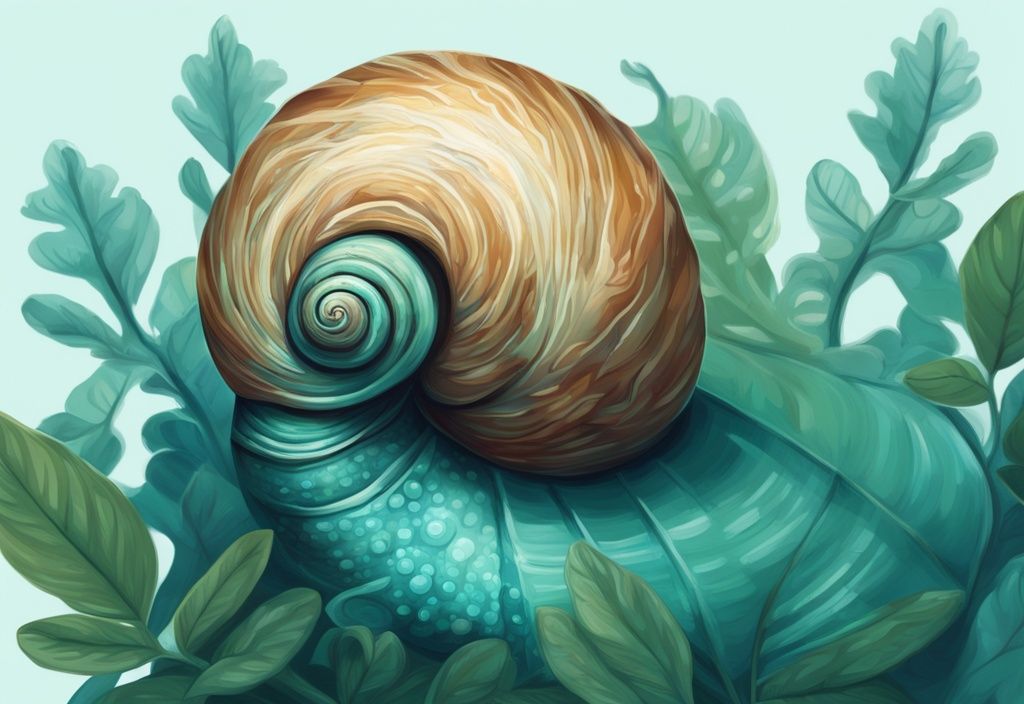Introduction to the Fascinating Pagoda Snail
Imagine a creature so unique that its very presence can transform the dynamics of your aquarium. Enter the Pagoda Snail, a marvel of nature with its intricately sculpted shell and beneficial role in aquatic ecosystems. But what makes this snail truly captivating is not just its beauty, but its ability to maintain the delicate balance of your tank environment.
Native to the serene waters of Southeast Asia, the Pagoda Snail, scientifically known as Brotia pagodula, is a freshwater gastropod that has captured the hearts of aquarists worldwide. Its distinctive shell, resembling the tiered roofs of ancient pagodas, is not only a visual delight but also a testament to its adaptability and resilience.
Whether you’re a seasoned aquarist or just beginning your journey into the world of aquariums, understanding the Pagoda Snail’s habitat, care requirements, and compatibility with other species is essential. This guide will unravel the mysteries of this enchanting snail, offering insights into its natural habitat, unique characteristics, and the pivotal role it plays in maintaining a healthy aquarium.
So, are you ready to dive into the world of Pagoda Snails and discover how they can enhance your aquatic experience? Let’s embark on this journey to explore everything you need to know about these fascinating creatures.
Introduction to the Fascinating Pagoda Snail
The Pagoda Snail, scientifically known as Brotia pagodula, is a freshwater marvel that belongs to the family Pachychilidae. Picture this: a snail whose shell resembles a multi-tiered pagoda tower, an architectural wonder often seen in Asia. It’s as if nature decided to craft a tiny piece of art that doubles as a living creature. This unique shell design not only captivates aquatic enthusiasts but also adds a decorative touch to any aquarium.
But there’s more to the Pagoda Snail than just its good looks. These snails are unsung heroes in the world of aquariums, playing a crucial role in maintaining ecological balance. They’re like the diligent janitors of the tank, tirelessly scavenging for algae and detritus. This natural cleaning service helps control algae growth, ensuring a clean and healthy environment for all tank inhabitants.
The Pagoda Snail’s intriguing shell and beneficial cleaning habits make it a favorite among aquarists. Their peaceful demeanor and compatibility with other non-aggressive species add to their appeal, making them a perfect fit for community tanks. However, they do have specific care needs, so they’re best suited for those who have some experience in aquarium maintenance.
Understanding the Natural Habitat of Pagoda Snails
Delving into the natural habitat of Pagoda Snails, or Brotia pagodula, unveils a fascinating world where these creatures thrive. Their environment is a blend of geographical and environmental factors that create the perfect conditions for their survival and growth.
Geographic Distribution
Pagoda Snails are native to the vibrant landscapes of Southeast Asia. You can find them in the bustling waterways of Thailand, Myanmar, Malaysia, and Indonesia. These snails have evolved to flourish in fast-flowing rivers and streams. The swift currents in these regions are not just a backdrop; they are essential for providing the oxygen-rich waters that Pagoda Snails need.
Environmental Preferences
When it comes to their environmental preferences, Pagoda Snails are quite particular. They thrive in water with a stable pH level between 7 and 8, and temperatures ranging from 70 to 88 °F (21 to 31 °C). Imagine the water as a cozy blanket, just the right temperature to keep them comfortable.

The hardness of the water, measured as kH, should ideally be between 5 and 30. This helps in the development of their beautiful, spiral shells. Think of it as the snails’ armor, needing just the right conditions to form perfectly.
The substrate, or the riverbed they call home, is best when sandy. This mimics their natural habitat, allowing them to burrow and explore. Dim lighting is another preference, reminiscent of the shaded streams they are used to. It’s like setting the mood lighting for a cozy evening.
For those looking to recreate this environment in an aquarium, strong filtration systems and well-oxygenated water are crucial. These elements replicate the fast-flowing habitats Pagoda Snails are accustomed to, ensuring they remain healthy and vibrant in their new home.
Distinctive Characteristics of Pagoda Snails
Discover the fascinating features of Pagoda Snails, from their unique shell shapes to their intriguing behaviors. These freshwater snails not only captivate with their appearance but also contribute significantly to the balance of aquarium ecosystems.
Unveiling the Unique Shell Shape
The Pagoda Snail, scientifically known as Brotia pagodula, is a marvel of nature, especially for those who appreciate aquatic life. Its shell is a masterpiece, drawing the eye with its whorled brown design adorned with large spikes. This creates a silhouette reminiscent of the multi-tiered pagoda towers found across Asia. Such intricate architecture not only serves as a sturdy shield but also enhances the visual appeal of any aquarium setting.
Interestingly, the shell’s appearance can vary significantly within wild populations, a phenomenon likely due to interbreeding within the genus Brotia. This variability ensures that each Pagoda Snail is a unique addition to your collection, offering a delightful blend of natural beauty and biological intrigue.
Decoding their Behavior and Movement
Pagoda Snails are not in a rush. Their slow and deliberate movement is typical of many snail species, yet it plays a crucial role in maintaining ecological balance within an aquarium. Their peaceful nature makes them perfect candidates for community tanks, where they coexist harmoniously with other non-aggressive species.
This tranquility allows them to thrive alongside various aquatic companions, contributing to a serene and balanced environment. If you’re interested in creating a Black Water Aquarium setup, these snails can be a beneficial addition due to their compatibility with diverse ecosystems. Their behavior is a testament to their adaptability and highlights their suitability for aquarists seeking a calm and visually appealing addition to their tanks.
Why Pagoda Snails are Beneficial for Aquariums
Pagoda Snails offer more than just visual appeal in aquariums. Their presence plays a significant role in maintaining a balanced and thriving aquatic environment. These snails contribute to algae control, tank cleanliness, and compatibility with other species, making them an excellent choice for aquarists seeking a harmonious ecosystem.
Role in Algae Control and Tank Cleanliness
Pagoda Snails, with their charming pagoda-shaped shells, are a boon for any aquarium. Think of them as the diligent custodians of your tank. They are exceptional at munching away on algae, those pesky green invaders that can cloud your water and obscure your view of the vibrant underwater world. By keeping algae in check, Pagoda Snails enhance water clarity and quality, creating a healthier habitat for all your aquatic friends.
But their cleaning duties don’t stop there. These snails also feast on detritus and decaying plant matter, acting like tiny vacuum cleaners. This natural cleaning process means less frequent manual cleaning for you, allowing you more time to enjoy your aquarium. It’s like having a little maintenance crew working around the clock!
Compatibility with Other Aquarium Species
Pagoda Snails are the epitome of peaceful cohabitants in a community tank. Imagine them as the friendly neighbors who get along with everyone. They peacefully coexist with a variety of aquatic species, from dwarf shrimp to non-carnivorous fish. Their gentle nature ensures they don’t disturb other tank inhabitants, promoting a serene and balanced aquatic environment.

However, a word of caution: avoid pairing them with aggressive species like Assassin Snails or crayfish, as these can pose a threat to our tranquil friends. By choosing compatible tank mates, you can craft a thriving ecosystem where Pagoda Snails and other peaceful species flourish together. It’s all about creating harmony in your underwater world!
Essential Care Guidelines for Pagoda Snails
Understanding the care needs of Pagoda Snails is essential for creating a thriving aquatic environment. From water conditions to diet and health, each aspect plays a crucial role in their well-being.
Optimal Water Conditions and Tank Setup
Think of Pagoda Snails as the discerning guests at a river-themed party. They prefer aquariums that echo their natural habitat, with a pH level between 7 and 8 and temperatures from 70 to 88 °F (21 to 31 °C). A robust filtration system is like the DJ of this party, keeping the water clean and lively, much like the fast-flowing rivers they adore.
A sandy substrate is their dance floor, reminiscent of their native riverbeds, while dim lighting sets the mood, reducing stress. Ensure the aquarium is fully cycled, with weekly water changes to maintain pristine conditions. Remember, copper is their kryptonite, so avoid copper-based medications to keep your snails healthy and happy.
Feeding: What Do Pagoda Snails Eat?
In the wild, Pagoda Snails are nature’s little recyclers, munching on decaying plant matter and detritus. In your aquarium, think of their diet as a balanced buffet. Supplement their meals with algae, vegetables, and commercial snail food to ensure they get all the nutrients they need.
Offering a variety of foods is like serving a diverse menu at a dinner party. Sinking pellets and blanched veggies, like zucchini or spinach, are not just tasty but also help keep the tank clean by reducing algae and consuming leftovers. A well-fed snail is a happy snail, and a happy snail means a cleaner tank for you!
Preventing Common Health Issues
Maintaining optimal water conditions is your frontline defense against health issues in Pagoda Snails. Soft or acidic water can be their downfall, leading to shell damage. Regularly check water hardness and pH levels, and consider calcium supplements if the water is naturally soft.
Think of regular water changes and monitoring as your routine health check-ups for the snails. They prevent stress and potential health problems, ensuring your snails live long and healthy lives. By creating a stable and clean environment, you can enjoy the vibrant presence of Pagoda Snails in your aquarium for years to come.
Breeding Pagoda Snails: A Detailed Guide
Breeding Pagoda Snails, or Brotia pagodula, is a unique endeavor that requires understanding their reproductive behavior and overcoming specific challenges. This guide delves into these aspects to help aquarists succeed in breeding these fascinating creatures.
Understanding their Reproductive Behavior
Pagoda Snails are viviparous, meaning they give birth to live young rather than laying eggs. This trait sets them apart from many other snail species. Typically, a female Pagoda Snail will produce a single juvenile at a time, which contributes to their slow population growth. Interestingly, there are usually more females than males in a population, influencing the breeding dynamics. Imagine a dance where the female leads, dictating the pace and rhythm of population growth. For aquarists, understanding these behaviors is crucial for successful breeding in captivity.
Overcoming Challenges in Breeding
Breeding Pagoda Snails in captivity can be challenging due to their specific environmental needs. These snails require precise water conditions, including stable pH levels and optimal temperatures that mimic their natural habitat. Their reproduction rate is relatively slow, with females producing only 1-3 juveniles at a time. This slow pace minimizes the risk of overpopulation in aquariums, much like a carefully curated art collection where each piece is treasured.
To enhance breeding success, focus on maintaining pristine water quality. Provide a habitat that closely resembles their natural environment. This includes ensuring adequate filtration and oxygenation, which are critical for their well-being and reproductive success. Think of it as creating a cozy home where every detail, from the lighting to the furniture, contributes to a harmonious living space.
Choosing Suitable Tank Mates for Pagoda Snails
Creating a harmonious aquarium environment requires careful selection of tank mates for Pagoda Snails. Understanding which species coexist peacefully and which to avoid can make all the difference in maintaining a thriving aquatic community.

Species that Coexist Well
Pagoda Snails, with their gentle demeanor, are ideal candidates for community tanks. They find perfect companions in small freshwater shrimp like Cherry or Amano shrimp. These shrimp not only share similar environmental needs but also play a vital role in algae control and tank cleaning. It’s like having a tiny cleaning crew that also enjoys a peaceful coexistence.
Another great choice for companions are other non-aggressive snails, such as Nerite or Mystery snails. These snails share a similar temperament, ensuring a calm and balanced aquarium. Imagine a serene underwater neighborhood where everyone gets along swimmingly!
Species to Avoid for a Harmonious Tank
To keep the peace in your aquarium, steer clear of aggressive species. Predatory snails like Assassin Snails can be a real menace due to their carnivorous habits. They see other snails as dinner, which is not ideal for your Pagoda Snails.
Crayfish are another species to avoid. Known for their territorial nature, they can be quite the bullies, causing stress or harm to your Pagoda Snails. By choosing tank mates that match the peaceful nature of Pagoda Snails, you ensure a tranquil environment where all inhabitants can thrive.
FAQs: Answering Your Burning Questions about Pagoda Snails
Pagoda Snails, with their unique spiral shells, are a fascinating addition to any aquarium. Here, we delve into some common questions about these intriguing creatures, offering insights that blend scientific understanding with practical advice.
What is the Average Lifespan of a Pagoda Snail?
With the right care, Pagoda Snails can live up to 5 years. Think of them as the marathon runners of the snail world, thriving in environments that closely mimic their natural habitat. Maintaining optimal water conditions is key to their longevity. Just like humans need clean air, these snails need clean water.
How to Differentiate Between Male and Female Pagoda Snails?
Ah, the age-old mystery of snail gender! Distinguishing between males and females is no easy task due to their similar appearance. Interestingly, the species tends to have more females, which can affect population dynamics in aquariums. It’s a bit like trying to guess the gender of a goldfish—tricky, but not impossible with experience.
Why Aren’t Pagoda Snails Recommended for Beginners?
Pagoda Snails are like the divas of the snail world. They require specific care conditions, making them a bit high-maintenance for beginners. Their sensitivity to water parameters and need for stable environments mean they’re better suited for seasoned aquarists. It’s like adopting a pet that demands a very particular diet and living conditions.
Can Pagoda Snails Coexist with Shrimp?
Yes, Pagoda Snails can peacefully coexist with shrimp. They’re generally harmonious and get along well with dwarf shrimp and other non-carnivorous species. Think of them as the friendly neighbors in your community tank, contributing to a balanced ecosystem without causing any fuss.
Conclusion
Pagoda Snails, with their mesmerizing pagoda-like shells, are a stunning addition to any aquarium. Their unique beauty not only elevates the visual charm of tanks but also contributes significantly to maintaining cleanliness by controlling algae and consuming detritus. However, these snails require specific care conditions to flourish, making them more suitable for aquarists with experience.
Their need for stable water parameters and sensitivity to copper-based medications demand careful attention to detail. Think of them as the delicate artists of the aquarium world, requiring a well-tuned environment to perform their best.
Moreover, conservation efforts are crucial to protect the natural habitats of Pagoda Snails in Southeast Asia. Preserving their fast-flowing river environments ensures their survival in the wild, allowing future generations to marvel at these fascinating creatures. By understanding and respecting their needs, aquarists can enjoy the benefits Pagoda Snails bring to their aquatic ecosystems while contributing to their conservation.
In essence, Pagoda Snails are not just decorative elements; they are vital members of the aquatic community. With the right care and a commitment to sustainability, you can create a balanced and thriving ecosystem in your aquarium. For those starting out, check out these saltwater aquarium tips for beginners to help ensure your aquatic environment is well-maintained.
